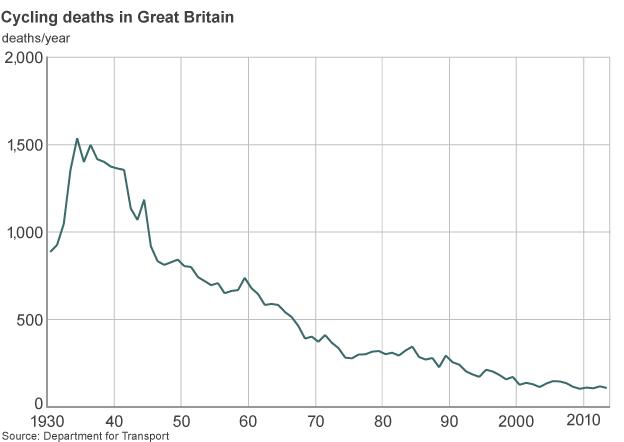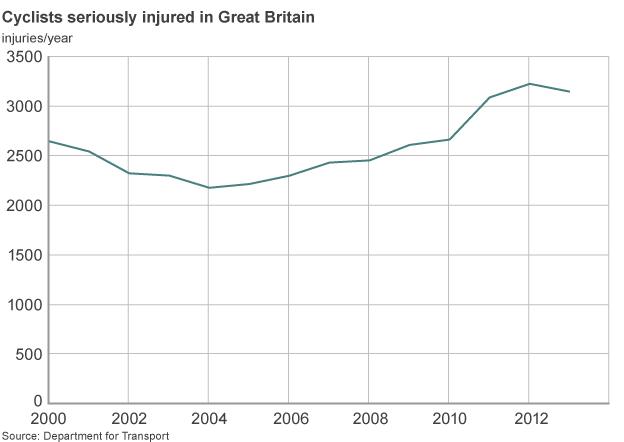How safe is cycling?
- Published

Cycling in Britain is often perceived as dangerous, but how much have the risks of riding a bike changed, and how do they compare with driving a car, asks statistician Jamie Jenkins.
There has been a huge fall in the number of deaths among cyclists in the past 80 years.
The figure reached its peak in 1934, when 1,536 pedal cyclists died in Great Britain. Last year there were 109 fatalities, according to the Department for Transport (DFT), and it's important to remember that there were considerably fewer people living in the country 80 years ago.
But before we think that 1934 was a bad year for cycling, remember that despite the lower population there are likely to have been far more cyclists. Owning a motor vehicle was much rarer and thus cycling as a primary means of transport would have been more common.
We do not know exactly how many cycle journeys there were in 1934, but the number of licensed cars on the road can give us some indication. In 1934 there were fewer than two million cars, while today there are about 28 million licensed cars. Now it is more common for a cyclist to also be a car driver and share their journeys between the two modes of travel.
Evidence presented in parliament in the 1930s suggested there were between 10 and 12 million cyclists, notes Carlton Reid, author of Roads Were Not Built For Cars. And they would have done more journeys than an equivalent 10 to 12 million cyclists in 2013.
So how safe is it to cycle on Britain's roads in 2014?

There are several ways to look at the risk of a death, based on, for example, the distance travelled, the number of journeys made or the amount of time spent travelling. These can be found in a DFT report, external from last year.
Starting with distance travelled, a cyclist travelling a mile in Great Britain is 15 times more likely to have a fatal accident than a car driver going the same distance. While this sounds alarming, the risk from death for both forms of travel is quite low.
In 2013 there was one death for every 29 million miles cycled, so you would expect one death for every 29,000 people who cycled the whole length of Britain.
But cycling a certain distance generally takes longer than it would take in a car, so over the same trip there is greater exposure to an accident for a cyclist. Based on the time spent travelling, a cyclist is five times more likely to have a fatal accident than a car driver.
Pedal cycle fatalities are falling at a time when cycle traffic is rising - road traffic estimates put cycle traffic in 2013 around 13% higher than the average over 2005-09, with deaths 16% lower.

But while a fall in fatalities is good news, there have been increases in recent years in the number of cyclists who have been seriously injured. In 2013 serious injuries were 31% higher than the average over 2005-09.
It is possible that falling deaths and rising serious injuries could be a result of lives being saved by the healthcare system, for example, with the use of specialist trauma centres.
An important factor in the likelihood of being seriously injured or a fatality is the type of road where an accident occurs. Rural roads carry 30% of cycle traffic but they accounted for 58% of pedal cyclist fatalities in 2013.

The Department for Transport puts this discrepancy down to traffic speed. Rural roads have much higher average speeds than urban roads and the extra speed leads to worse accidents for cyclists. But another factor could be that it takes ambulances longer to reach accidents in more remote areas.
So cyclists do have a greater risk of death than car drivers, and they are more likely to die on a rural road than in a city, but their overall risk of death is low.
It's worth bearing in mind that the statistics show the extra danger around heavy goods vehicles. Between 2009 and 2013, HGVs were involved in around a quarter of cyclist deaths despite comprising only 5% of traffic in Great Britain.
All this week, BBC Breakfast will be featuring a series of films on cycling. On Wednesday it will explore whether or not it is safe to cycle with headphones.
Subscribe to the BBC News Magazine's email newsletter to get articles sent to your inbox.